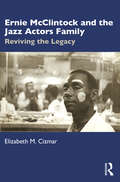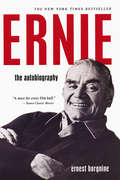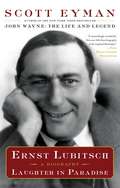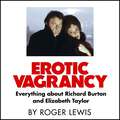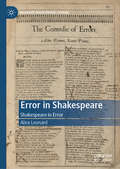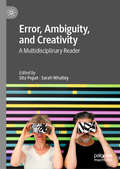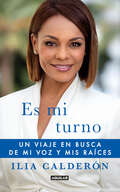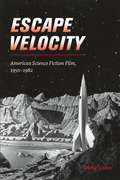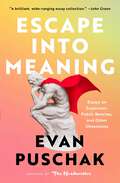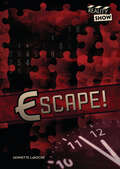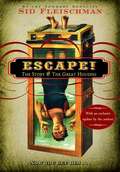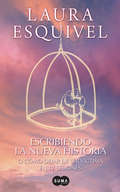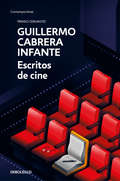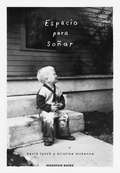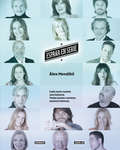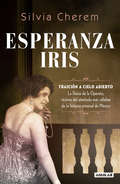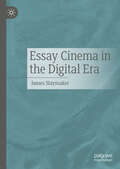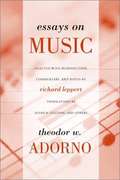- Table View
- List View
Ernie McClintock and the Jazz Actors Family: Reviving the Legacy
by Elizabeth M. CizmarErnie McClintock and the Jazz Actors Family is a critical biography examining the life and work of Ernie McClintock, the founder of the Jazz Acting Method and 1997 recipient of the Living Legend Award from the National Black Theatre Festival, whose inclusive contributions to acting and actor training have largely remained on the fringes of scholarship and practice. Based on original archival research and interviews with McClintock’s students and peers, this book traces his life from his childhood in Chicago to Harlem in the 1960s at the height of the Black Arts Movement, to Richmond, Virginia in 2003, paying particular attention to his Black Power–influenced, culturally specific acting theory and versatile Black theatrical productions. As a biographical study, this book establishes McClintock as a leading figure of the Black Theatre Movement, proven by the Jazz Acting technique, his critically acclaimed productions, and his leadership positions in organizations such as the Black Theatre Alliance. Ernie McClintock and the Jazz Actors Family explores how the Jazz Acting technique was applied in productions such as N.R. Davidson’s El Hajj Malik, Derek Walcott’s Dream on Monkey Mountain, Cheryl West’s Before It Hits Home, Endesha Mae Holland’s From the Mississippi Delta, and many collectively-authored pieces. The book also investigates why he has been excluded from dominant theatre histories, especially considering how, as a gay Black man, he persistently defied the status quo, questioning practices of administrators of theatres and mainstream theatrical standards. Ernie McClintock and the Jazz Actors Family is situated at the intersection of Black acting theory, Black Arts Movement history, and Black queer studies, and is an illuminating study of an important figure for actors, acting teachers, acting students, and cultural historians. This is an essential resource for readers who are seeking histories and approaches outside of a white, straight, Eurocentric framework.
Ernie McClintock and the Jazz Actors Family: Reviving the Legacy
by Elizabeth M. CizmarErnie McClintock and the Jazz Actors Family is a critical biography examining the life and work of Ernie McClintock, the founder of the Jazz Acting Method and 1997 recipient of the Living Legend Award from the National Black Theatre Festival, whose inclusive contributions to acting and actor training have largely remained on the fringes of scholarship and practice.Based on original archival research and interviews with McClintock’s students and peers, this book traces his life from his childhood in Chicago to Harlem in the 1960s at the height of the Black Arts Movement, to Richmond, Virginia in 2003, paying particular attention to his Black Power–influenced, culturally specific acting theory and versatile Black theatrical productions. As a biographical study, this book establishes McClintock as a leading figure of the Black Theatre Movement, proven by the Jazz Acting technique, his critically acclaimed productions, and his leadership positions in organizations such as the Black Theatre Alliance. Ernie McClintock and the Jazz Actors Family explores how the Jazz Acting technique was applied in productions such as N.R. Davidson’s El Hajj Malik, Derek Walcott’s Dream on Monkey Mountain, Cheryl West’s Before It Hits Home, Endesha Mae Holland’s From the Mississippi Delta, and many collectively-authored pieces. The book also investigates why he has been excluded from dominant theatre histories, especially considering how, as a gay Black man, he persistently defied the status quo, questioning practices of administrators of theatres and mainstream theatrical standards.Ernie McClintock and the Jazz Actors Family is situated at the intersection of Black acting theory, Black Arts Movement history, and Black queer studies, and is an illuminating study of an important figure for actors, acting teachers, acting students, and cultural historians. This is an essential resource for readers who are seeking histories and approaches outside of a white, straight, Eurocentric framework.
Ernie: The Autobiography
by Ernest BorgnineWe wept at his Oscar-winning role in Marty. . .we gasped when he took on Frank Sinatra in From Here to Eternity. . .we were riveted by his compelling performances in The Dirty Dozen, Bad Day at Black Rock, and Ice Station Zebra. . .and we laughed at his television sitcom McHale's Navy. We loved all of Ernest Borgnine's many portrayals, but what did we know about the man behind the famous roles? Now for the first time, he tells us in his own words the fascinating story of his life in this witty, candid, and revealing memoir. For more than fifty years, Ernest--or "Ernie" as he's known to his friends--has been one of the most recognized, celebrated stars in Hollywood as well as a respected, talented actor, and a living legend. Stretching from his childhood as the son of Italian immigrants to a spectacular career that is still thriving in his 91st year, from the early days of live TV to the voiceovers for The Simpsons and SpongeBob SquarePants, Ernie tells of the trials and tribulations on his road to fame, the friendships he shared with some of the silver screen's biggest stars, and the glamorous leading ladies he loved. Acclaimed for his ability to play sensitive and tough-guy roles equally well, he was also famous for squaring off against some of Hollywood's most formidable actresses--including Bette Davis in A Catered Affair and Joan Crawford in Johnny Guitar. Recalling his experiences starring in classic movies such as The Poseidon Adventure, The Wild Bunch, and Escape from New York, he reveals personal insights and irresistible stories about cinema's greatest icons--including Spencer Tracy, James Stewart, Kirk Douglas, Montgomery Clift, Gary Cooper, Janet Leigh, Raquel Welch, Gene Hackman, Rock Hudson, Sammy Davis, Jr., Tony Curtis, Alan Ladd, Glenn Ford, and Burt Lancaster. And with characteristic frankness, he also talks about his off-screen loves and passions. A must for every film buff, Ernie: An Autobiography is a fascinating memoir--filled with secrets, well-remembered details, and never-before-told stories--of a star who has thrived in the changing world of Hollywood for more than half a century, and endeared himself to legions of fans everywhere. "(Borgnine's) anecdotes are gleefully self-deprecating. . .he comes off as the kind of guy you'd like to have a beer with." --NY Post "With astute observations on the Hollywood hierarchy and tales about everyone from Lee Marvin and Steve McQueen to Bette Davis and Kim Novak, (Borgnine) writes with an unassuming, no-nonsense tone. His love of filmmaking and his respect for his fellow actors permeates the pages of this engaging and satisfying memoir." --Publishers Weekly "Modest and sweet. . .nicely boiled. Borgnine neither lashes out nor pulls punches." --Entertainment Weekly ". . .a satisfying detailed account of a decades-long career that also included memorable roles in durable blockbusters like The Wild Bunch and The Poseidon Adventure. He comes across as an unspoiled, nice guy who enjoyed his success. . .One of the finest unghosted Hollywood autobiographies." --ALA Booklist "A super read. . .Ernie: The Autobiography by Ernest Borgnine is as nifty as he is." --Cindy Adams, NY Post
Ernst Lubitsch: Laughter in Paradise
by Scott Eyman"Highly recommended" (Library Journal): The only full-length biography of legendary film director Ernst Lubitsch, the director of such Hollywood classics as Trouble in Paradise, Ninotchka, and The Shop Around the Corner.In this groundbreaking biography of Ernst Lubitsch, undeniably one of the most important and influential film directors and artists of all time, critic and biographer Scott Eyman, author of the critically acclaimed New York Times bestseller John Wayne, examines not just the films Lubitsch created, but explores as well the life of the man, a life full of both great successes and overwhelming insecurities. The result is a fascinating look at a man and an era--Hollywood's Golden Age. Born in Berlin and transported to Hollywood in the 1920s with the help of Mary Pickford, Lubitsch brought with him a level of sophistication and subtlety previously unknown to American movie audiences. He was quickly established as a director of unique quality and distinction. He captivated audiences with his unique "touch," creating a world of fantasy in which men are tall and handsome (unlike Lubitsch himself) and humorously adept at getting women into bed, and where all the women are beautiful and charming and capable of giving as well as receiving love. He revived the flagging career of Marlene Dietrich and, in Ninotchka, created Greta Garbo's most successful film. When movie buffs speak of "the Lubitsch touch," they refer to a sense of style and taste, humor and humanity that defined the films of one of Hollywood's all-time great directors. In the history of the medium, no one has ever quite equaled his unique talent. Written with the cooperation of an extraordinary ensemble of eyewitnesses, and unprecedented access to the files of Paramount Pictures, this is an enthralling biography as rich and diverse as its subject--sure to please film buffs of all types, especially those who champion Lubitsch as one of the greatest filmmakers ever.
Erotic Vagrancy: Everything about Richard Burton and Elizabeth Taylor
by Roger LewisThe comic genius of English writing takes on Hollywood, delusion, celebrity and last century's ultimate glamour couple: Richard Burton and Elizabeth Taylor.Richard Burton and Elizabeth Taylor were a Sixties supercharged couple in an era of supercharged couples. As a pairing they were fantasy figures, impossibly desirable. Liz supple and soft, in perfumes and furs - yet with something demonic and lethal about her. Dick, in turn, with his ravaged, handsome face, looked as though lit by silver moonlight - poised to turn into a wolf.Roger Lewis uses this glamorous and damaged pair as the starting point to tell the story of an age of excess: the freaks and groupies, the private jets and jewels and the yachts sailing in an azure sea; the magnificent bad taste and greed. It is about the clash of worlds: the filth and decay of South Wales and the grandeur and elegance of Old Hollywood; the fantasies we have about film stars and the fantasies the Burtons had about each other.'Brilliantly funny . . . the book of the year' - Sunday Times'By turns, funny, tragic, tender and vicious . . . a word-of-mouth sensation' - Guardian(P) 2023 Quercus Editions Ltd
Erotic Vagrancy: Everything about Richard Burton and Elizabeth Taylor
by Roger Lewis'One of the very best biographies I have ever read' STEPHEN FRY'A hot thunderstorm of a book' DAVID HARE'Erotic Vagrancy gave me a week of pure joy' CRAIG BROWN'Unputdownable' TONY PALMER'A genius writer' LYNN BARBERRichard Burton and Elizabeth Taylor were a Sixties supercharged couple in an era of supercharged couples. As a pairing they were fantasy figures, impossibly desirable. Liz supple and soft, in perfumes and furs - yet with something demonic and lethal about her. Dick, in turn, with his ravaged, handsome face, looked as though lit by silver moonlight - poised to turn into a wolf. Roger Lewis uses this glamorous and damaged pair as the starting point to tell the story of an age of excess: the freaks and groupies, the private jets and jewels and the yachts sailing in an azure sea; the magnificent bad taste and greed. It is about the clash of worlds: the filth and decay of South Wales and the grandeur and elegance of Old Hollywood; the fantasies we have about film stars and the fantasies the Burtons had about each other.
Erotic Vagrancy: Everything about Richard Burton and Elizabeth Taylor
by Roger Lewis'One of the very best biographies I have ever read' STEPHEN FRY'A hot thunderstorm of a book' DAVID HARE'Erotic Vagrancy gave me a week of pure joy' CRAIG BROWN'Unputdownable' TONY PALMER'A genius writer' LYNN BARBERRichard Burton and Elizabeth Taylor were a Sixties supercharged couple in an era of supercharged couples. As a pairing they were fantasy figures, impossibly desirable. Liz supple and soft, in perfumes and furs - yet with something demonic and lethal about her. Dick, in turn, with his ravaged, handsome face, looked as though lit by silver moonlight - poised to turn into a wolf. Roger Lewis uses this glamorous and damaged pair as the starting point to tell the story of an age of excess: the freaks and groupies, the private jets and jewels and the yachts sailing in an azure sea; the magnificent bad taste and greed. It is about the clash of worlds: the filth and decay of South Wales and the grandeur and elegance of Old Hollywood; the fantasies we have about film stars and the fantasies the Burtons had about each other.
Error in Shakespeare: Shakespeare in Error (Palgrave Shakespeare Studies)
by Alice LeonardThe traditional view of Shakespeare’s mastery of the English language is alive and well today. This is an effect of the eighteenth-century canonisation of his works, and subsequently Shakespeare has come to be perceived as the owner of the vernacular. These entrenched attitudes prevent us from seeing the actual substance of the text, and the various types of error that it contains and even constitute it. This book argues that we need to attend to error to interpret Shakespeare’s disputed material text, political-dramatic interventions and famous literariness. The consequences of ignoring error are especially significant in the study of Shakespeare, as he mobilises the rebellious, marginal, and digressive potential of error in the creation of literary drama.
Error, Ambiguity, and Creativity: A Multidisciplinary Reader
by Sarah Whatley Sita PopatThis book offers a set of eleven discipline-specific chapters from across the arts, humanities, psychology, and medicine. Each contributor considers the creative potential of error and/or ambiguity, defining these terms in the particular context of that discipline and exploring their values and applications. Themes include error in choreography, poetry, media art, healthcare, psychology, critical typography and mixed reality performance. The book emerges from a core question of how dance research and HCI can inform each other through consideration of error, ambiguity and ‘messiness’ as methodological tools. The digital age had heralded the possibility that error could be eradicated by the logic of computers but several chapters focus on glitch in arts practices that exploit errors in computer programmes, or even create programmes specifically to produce errors. Together, the chapters explore how error can take us somewhere different or somewhere new, to develop a new, more interesting way of working.
Eruption in the Canyon: 212 Days & Nights with the Genius of Eddie Van Halen
by Andrew BennettA revelatory, fly-on-the-wall collection of photographs and stories documenting Eddie Van Halen at work in his famed but seldom seen 5150 studio, from the 2004 reunion with Sammy Hagar through the 2007 reunion with David Lee Roth.&“When kids ask me how it feels to be a rock star, I say, &‘I&’m not a rock star. I&’m not in it for the fame, I&’m in it because I like to play.&’&” Eddie Van Halen A fortuitous call from a stranger in the middle of the night led to a once-in-a-lifetime assignment. The stranger was Eddie Van Halen. The assignment, as Eddie related it, was to &“capture the truth. Show people how hard I work, because that&’s the truth.&” Having no idea where this would lead or in what form it might be shared, Andrew Bennett spent portions of the next two years relentlessly documenting everything that occurred inside Eddie&’s sanctuary: from rehearsals, recording sessions, and revealing conversations, to vicious arguments, a brotherly brawl, and a wild heist attempt in the middle of the night. Bennett memorialized every square foot of that sacred space, every piece of equipment, and every guitar—including Eddie&’s beloved Frankenstrat. Featuring more than two hundred photographs, and accompanied by intimate reflections on what the author witnessed, Eruption in the Canyon presents an incomparable portrait of one of the most revered artists in history.
Es mi turno: Un viaje en busca de mi voz y mis raíces
by Ilia CalderonLAS MEMORIAS INSPIRADORAS, PERTINENTES Y PROVOCADORAS DE ILIA CALDERÓN -LA PRIMERA PRESENTADORA AFROLATINA EN UN NOTICIARIO HISPANO DE PREEMINENCIA EN LOS ESTADOS UNIDOS- ACERCA DE SEGUIR SUS SUEÑOS, SUPERAR PREJUICIOS Y ACOGER SU IDENTIDAD. De niña, Ilia Calderón se sentía como una típica niña colombiana. En el Chocó, la provincia afrolatina donde se crio, tu piel podría ser de cualquier tono y aún serías considerado familia. Pero cuando dejó su comunidad para asistir a la escuela secundaria y la universidad en Medellín, todo cambió. A partir de ese momento, resolvió volverse "sorda" al racismo, decidida a superar el prejuicio, incluso cuando le repetían que los trabajos prominentes de presentador de noticias no eran para ella. Cuando un giro del destino le presentó una oportunidad única en la cadena noticiera Telemundo en Miami, estaba emocionada de comenzar una nueva vida -e identidad- en los Estados Unidos, donde las fronteras raciales, creía, se habían disuelto hace mucho tiempo y la igualdad era la regla. Sin embargo, se enfrentó a otro tipo de discriminación racial como una mujer inmigrante de color que le hablaba en español a la comunidad latina cada vez más marginada. En los últimos nueve años, Ilia ha reportado desde la primera línea de eventos históricos como el huracán Katrina, los terremotos en México, las elecciones presidenciales de los Estados Unidos de 2016 y la crisis pandémica del COVID-19. Ahora, Ilia corre el telón de los altibajos de su extraordinaria vida y carrera. Desde luchas internas personales hasta problemas profesionales analiza cómo construyó su identidad en medio de la violencia con carga de motivos raciales y la polarización política. Sobre la marcha, ella muestra cómo ha superado el miedo y enfrentado el odio de cara a cara, todo en nombre de crear un mundo mejor para su joven hija, Anna. "Existen muy pocas historias de superación que se acerquen siquiera a las de Ilia como madre y periodista. Qué suerte la mía de trabajar con ella y ser testigo de esta mujer cambiando al mundo."-Jorge Ramos, presentador principal de Noticiero Univision "Esta es la historia de una niñita quién creció con grandes carencias en una humilde casa de madera, que se inundaba cada vez que el río crecía, y quién aprendió a luchar y prepararse para llegar a ser la primera afrolatina en el noticiero más importante en la televisión en español de los EE. UU. La lección que Ilia Calderón aquí nos enseña es clara: ¡todo se puede!" -María Antonieta Collins, autora de bestsellers y corresponsal principal de Noticiero Univisión
Escape Velocity: American Science Fiction Film, 1950–1982 (Wesleyan Film Ser.)
by Bradley SchauerToday, movie theaters are packed with audiences of all ages marveling to exciting science fiction blockbusters, many of which are also critically acclaimed. However, when the science fiction film genre first emerged in the 1950s, it was represented largely by exploitation horror films—lurid, culturally disreputable, and appealing to a niche audience of children and sci-fi buffs. How did the genre evolve from B-movie to blockbuster? Escape Velocity charts the historical trajectory of American science fiction cinema, explaining how the genre transitioned from eerie low-budget horror like It Came from Outer Space to art films like Slaughterhouse-Five, and finally to the extraordinary popularity of hits like E.T. Bradley Schauer draws on primary sources such as internal studio documents, promotional materials, and film reviews to explain the process of cultural, aesthetic, and economic legitimation that occurred between the 1950s and 1980s, as pulp science fiction tropes were adapted to suit the tastes of mainstream audiences. Considering the inescapable dominance of today’s effects-driven blockbusters, Escape Velocity not only charts the history of science fiction film, but also gives an account of the origins of contemporary Hollywood.
Escape into Meaning: Essays on Superman, Public Benches, and Other Obsessions
by Evan PuschakProducer, editor, and writer behind the highly addictive, informative, and popular YouTube channel The Nerdwriter, Evan Puschak presents an unconventional and whip-smart essay collection about topics as varied as Superman, politics, and public benches. As YouTube&’s The Nerdwriter, Evan Puschak plays the polymath, posing questions and providing answers across a wide range of fields—from the power of a split diopter shot in Toy Story 4 to the political dangers of schadenfreude. Now, he brings that same insatiable curiosity and striking wit to this engaging and unputdownable essay collection. Perfect for fans of Trick Mirror and the writing of John Hodgman and Chuck Klosterman, Escape into Meaning is a compendium of fascinating insights into obsession. Whether you&’re interested in the philosophy of Jerry Seinfeld or how Clark Kent is the real hero, there&’s something for everyone in this effervescent collection.
Escape! (Reality Show)
by Jannette LaRocheFour high school friends sign up for a TV escape-room competition, but they're assigned to a set that's actually a series of rooms. They have twelve hours to find a way out, but the faster they're able to do it, the higher their prize money will be. As the clues get harder and the time ticks by, tensions run high and confrontations occur. Soon the prize money isn't the only reason they're all desperate to escape.
Escape! The Story of the Great Houdini
by Sid FleischmanBiography of Houdini. How did he walk through walls, escape drowning, and shatter iron chains? The rare photos and the exclusive update about the rumor that Houdini was poisoned might help. But remember, a true magician never reveals his tricks.
Escribiendo la nueva historia
by Laura EsquivelEn este ensayo, Laura Esquivel demuestra cómo el guión cinematográfico es una herramienta para la conciencia que nos permite afrontar nuestro pasado y nuestros temores. De Laura Esquivel, autora del bestseller Como agua para chocolate. Si queremos verdaderamente que la realidad cambie, debemos empezar por un cambio personal. Pero, ¿qué es lo que debemos cambiar? El nuevo libro de Laura Esquivel, Escribiendo la nueva historia o cómo dejar de ser víctima en doce lecciones, es una original propuesta para reflexionar sobre lo que queremos hacer con nuestras vidas, sobre todo cuando perdemos el norte. Escrito con el estilo inconfundible de la autora de Como agua para chocolate, este ensayo nos propone un método para retomar las riendas de la existencia mediante la escritura, gracias, especialmente, a la técnica del guión cinematográfico. Para rediseñar nuestra vida debemos rescribir el guión de la misma. Empezar por los antecedentes, el porqué somos como somos, de qué forma el pasado afecta al resto de nuestras vidas sin que nos demos cuenta. Manejar los miedos y poder superarlos implica que debemos estar listos para cambiar, para ser lo que queríamos ser desde un principio. Porque lo que verdaderamente importa es qué historia contamos, es decir, en qué historia queremos que se convierta nuestra vida y la realidad misma. Lo que ha dicho la crítica: "Este libro es una herramienta para el cambio, para ayudar a dejar los miedos, las culpas, esa idea de que alguien tiene un poder superior al nuestro". -Ericka Montaño Garfias, La Jornada. "Un ensayo acorde con los tiempos de rebelión que corren". -Hoy Extremadura.
Escritos de cine (estuche: Un oficio del siglo xx, Arcadia todas las noches, Cine o Sardina)
by Guillermo Cabrera InfanteLas tres colecciones de artículos sobre cine de Guillermo Cabrera Infante en un estuche que se disfruta como una función. Director de la cinemateca de Cuba y crítico de cine en su juventud, guionista de Hollywood en su madurez, Guillermo Cabrera Infante fue un apasionado cinéfilo toda su vida. El presente estuche reúne sus tres colecciones de ensayos sobre el tema: Un oficio del siglo xx, Arcadia todas las noches y Cine o sardina. En ellas brillan su espíritu lúdico y la fina ironía, que nos ayudan a comprender el sentido, el contexto y la factura del séptimo arte. De texto en texto y de mirada en mirada, Cabrera Infante repasa la obra de Orson Welles, Alfred Hitchcock, Howard Hawks, John Huston o Vincente Minnelli, así como una plétora de películas clásicas y modernas. Si el cine es el protagonista indiscutible, el crítico-escritor no deja de darle la réplica. Del diálogo entre la pantalla y la palabra surgen textos que no solo aportan una valiosa información, sino que se disfrutan como verdaderas funciones. Sobre el autor y la obra:«Para los que estudiábamos cine, Un oficio del siglo XX era un libro de cabecera.»Fernando Trueba «Ha convertido la crítica cinematográfica en un género literario gracias a su riqueza verbal y a su imaginación.»Mario Vargas Llosa «Cabrera Infante es casi una enciclopedia del cine hollywoodense.»Jacobo Machover, Revista de Libros
Espacio para soñar
by David Lynch Kristine McKennaDavid Lynch realiza una original incursión en el género biográfico. Un libro magnético y particular. Espacio para soñar ofrece una mirada insólita a la vida personal y creativa del cineasta David Lynch, a través de sus propias palabras y las de sus colegas más próximos, amigos y parientes. En este libro singular, a caballo entre la biografía y las memorias, David Lynch se sincera por primera vez acerca de una vida dedicada a perseguir un imaginario único, deteniéndose en las penurias y las luchas que soportó para llevar a buen puerto sus proyectos heterodoxos. Las reflexiones de Lynch --líricas, íntimas y sin tapujos-- parten, capítulo tras capítulo, de las secciones biográficas que aporta su estrecha colaboradora Kristine McKenna, sustentadas en más de cien entrevistas inéditas con ex mujeres sorprendentemente francas, miembros de su familia, actores, agentes, músicos y colegas en todo tipo de disciplinas, cada uno con su propia versión de lo ocurrido. Espacio para soñar es un libro llamado a no perecer jamás, un pase exclusivo a las bambalinas de la vida y la mente de uno de los artistas más enigmáticos y sustancialmente originales de nuestro tiempo. La crítica ha dicho...«Si esperaban que la biografía de David Lynch fuese como cualquier otra, es que nunca han visto una de sus películas. Un libro fascinante.»The New York Times «Espacio para soñar bien podría ser el evangelio según David Lynch. Aquí hay infinidad de informaciones inéditas incluso para los más fanáticos. Y todo esta contado con el formidable encanto del cineasta, una mezcla de entusiasmo juvenil y sabidurá cósmica.»The Washington Post «Las memorias de David Lynch iluminan los orígenes de su arte. El humor y las excentricidades de sus recuerdos y observaciones son uno de los innegables atractivos de este libro.»The Economist «Lynch estodo un maestro para los locos perversos e inquietantes, y también para los locos del montón.»The Sunday Times «Un libro gozosamente fuera de lo convencional. Lynch escribe como habla. Es plana y llanamente directo, alegremente profano y se entusiasma repentinamente con lo más inesperado.»The Big Issue
Espacio para soñar
by David Lynch Kristine McKennaDavid Lynch realiza una original incursión en el género biográfico. Un libro magnético y particular. Espacio para soñar ofrece una mirada insólita a la vida personal y creativa del cineasta David Lynch, a través de sus propias palabras y las de sus colegas más próximos, amigos y parientes. En este libro singular, a caballo entre la biografía y las memorias, David Lynch se sincera por primera vez acerca de una vida dedicada a perseguir un imaginario único, deteniéndose en las penurias y las luchas que soportó para llevar a buen puerto sus proyectos heterodoxos. Las reflexiones de Lynch --líricas, íntimas y sin tapujos-- parten, capítulo tras capítulo, de las secciones biográficas que aporta su estrecha colaboradora Kristine McKenna, sustentadas en más de cien entrevistas inéditas con ex mujeres sorprendentemente francas, miembros de su familia, actores, agentes, músicos y colegas en todo tipo de disciplinas, cada uno con su propia versión de lo ocurrido. Espacio para soñar es un libro llamado a no perecer jamás, un pase exclusivo a las bambalinas de la vida y la mente de uno de los artistas más enigmáticos y sustancialmente originales de nuestro tiempo. La crítica ha dicho...«Si esperaban que la biografía de David Lynch fuese como cualquier otra, es que nunca han visto una de sus películas. Un libro fascinante.»The New York Times «Espacio para soñar bien podría ser el evangelio según David Lynch. Aquí hay infinidad de informaciones inéditas incluso para los más fanáticos. Y todo está contado con el formidable encanto del cineasta, una mezcla de entusiasmo juvenil y sabidurá cósmica.»The Washington Post «Las memorias de David Lynch iluminan los orígenes de su arte. El humor y las excentricidades de sus recuerdos y observaciones son uno de los innegables atractivos de este libro.»The Economist «Lynch estodo un maestro para los locos perversos e inquietantes, y también para los locos del montón.»The Sunday Times «Un libro gozosamente fuera de lo convencional. Lynch escribe como habla. Es plana y llanamente directo, alegremente profano y se entusiasma repentinamente con lo más inesperado.»The Big Issue «Descubrimos o redescubrimos aspectos singulares de su singular personalidad, todo ello desde una perspectiva honesta, algo excéntrica y también a ratos divertida y cálida. [...] A medio camino entre la biografía y las memorias, es un documento esencial para comprender mejor su a veces incomprensible universo.»Fotogramas «Para los que aman el delirio cinematográfico lynchiano. Espacio para soñar acaba por convertirse en un artefacto biográfico curioso e inevitablemente extraño.»Zenda Libros
España en serie. Cada serie cuenta una historia y todas juntas cuentan nuestra historia
by Álex MendíbilUn viaje a través del tiempo, la realidad y la ficción. Todas las series cuentan una historia y todas juntas cuentan nuestra historia. España en serie parte de un trabajo documental minucioso elaborado por Canal + durante un año y medio de producción, con más de 90 entrevistas a algunas de las actrices, actores, guionistas, directores y productores de televisión más importantes de las últimas décadas. Este libro reconstruye y amplía ese valioso material, que acapara los principales acontecimientos históricos y sociales de la ficción televisiva española, por y para los amantes de las series. La historia de España se cuenta a lo largo de estas páginas desde una nueva óptica, con un peculiar orden cronológico que empieza en Hispania para llegar a las series del futuro como Plutón BRB Nero, permitiendo así un análisis horizontal de cada época. Críticas de televisión, testimonios de los artistas, de los profesionales y un poderoso material gráfico completan un estudio pormenorizado y exquisito. De forma simultánea se alza en España en serie una visión sociológica ya que la interpretación de los acontecimientos varía en función de la década y de la situación del país. ¿Cómo se veía la España de los Reyes Católicos en los años del destape o de la movida y cómo se ve ahora con Isabel? ¿Cómo eran los personajes de las series de la Transición y cómo los ve Cuéntame? Gracias al oficio y a la prosa de Álex Mendíbil la lectura de este libro se convierte en una gratificante experiencia, en un recuerdo de los mejores momentos vividos enfrente del televisor. Un recorrido por más de 50 años de historia de la televisión y 23 siglos de historia de España, un viaje a través del tiempo, la realidad y la ficción. Los protagonistas han dicho... «La que llega a todos: esa es la serie buena». Antonio Resines «La teleme llevó a dedicarme a ser actriz». Carmen Machi «La ficción llegó para quedarse y se va a quedar. El público demanda cosas con las que se sienta identificado». Emilio Aragón «Hay momentos de éxtasis en la tele». Javier Cámara «Tenemos necesidad de conocer nuestra propia Historia». Josefina Molina «El espectador, finalmente, lo que tiene que hacer es conmoverse con lo que aparece por la tele». Juan Echanove «Somos la última generación que empezamos en blanco y negro. Y cuando desaparezcamos, ya sólo quedarán los archivos». José Sancho «Yo un día abrí El País y ponía que los tres personajes más populares de España eran Letizia Ortiz, Fernando Alonso y Fernando Tejero y a mí aquello me horrorizó». Fernando Tejero «España en serie cuenta la historia de un país a través de una nueva óptica y con un peculiar orden cronológico». El Siglo de Europa Reseñas: «Sobre emociones e historia, aunque contemporánea, gira el volumen de España en serie, escrito por Álex Mendíbil con motivo del programa del mismo título emitido recientemente por Canal + y en el que se recoge el archivo de la memoria para contar la historia de España en series». Diario de Noticias
Esperanza Iris
by Silvia CheremLa vida y sombra, la luz y la tormenta de una mujer apasionada, intensa, inolvidable. Esperanza Iris, quien deslumbró por su tesón, incomparable gracia y talento, fue una diva prodigiosa que en 1918, con capital propio, edificó uno de los teatros más emblemáticos de la Ciudad de México. Lamentablemente el esplendor de su trayectoria artística fue nublado al final de sus días por un monstruoso atentado: su tercer marido, Paco Sierra, puso una bomba en un avión de Mexicana de Aviación el 24 de septiembre de 1952. El crimen, uno de los más célebres de la historia, mantuvo en vilo a la sociedad mexicana durante más de una década y llevó a la grandiosa Esperanza al derrumbe existencial: de ser aclamada con fervor, la Reina de la Opereta fue exiliada de la historia, lapidada con las piedras de la indiferencia y el olvido. Esta biografía novelada y basada en hechos históricos, te permite adentrarte en la piel de los personajes; retrata a la estrella del espectáculo no sólo en la cima de su éxito, también la descubre en su casa oscura, en la penumbra de su habitación, encerrada por el dolor, el desamor y la soledad.
Esperanza Iris
by Silvia CheremLa vida y sombra, la luz y la tormenta de una mujer apasionada, intensa, inolvidable. Esperanza Iris, quien deslumbró por su tesón, incomparable gracia y talento, fue una diva prodigiosa que en 1918, con capital propio, edificó uno de los teatros más emblemáticos de la Ciudad de México. Lamentablemente el esplendor de su trayectoria artística fue nublado al final de sus días por un monstruoso atentado: su tercer marido, Paco Sierra, puso una bomba en un avión de Mexicana de Aviación el 24 de septiembre de 1952. El crimen, uno de los más célebres de la historia, mantuvo en vilo a la sociedad mexicana durante más de una década y llevó a la grandiosa Esperanza al derrumbe existencial: de ser aclamada con fervor, la Reina de la Opereta fue exiliada de la historia, lapidada con las piedras de la indiferencia y el olvido. Esta biografía novelada y basada en hechos históricos, te permite adentrarte en la piel de los personajes; retrata a la estrella del espectáculo no sólo en la cima de su éxito, también la descubre en su casa oscura, en la penumbra de su habitación, encerrada por el dolor, el desamor y la soledad.
Essay Cinema in the Digital Era
by James SlaymakerThis book explores the impact of digital technology on the essay film in the early 21st century, arguing that the cinematic essay has been associated with technological evolution throughout its history. The author considers the output of four towering figures in essay filmmaking: Harun Farocki, Chris Marker, Chantal Akerman and Jean-Luc Godard, and explores the ways in which these directors utilise aesthetic strategies, editing techniques, and modes of spectatorial address that are rooted in the capabilities of digital technologies. Slaymaker conceptualises the cinematic essay as a self-reflexive mode of nonfiction cinema—one that foregrounds the filmmaking apparatus and the act of its own making, and which thereby launches an inquiry into the ontological nature of the cinematic image, the tools which construct it, and the wider artistic landscape in which it is embedded.
Essays on Music
by Theodor W. Adorno Richard D. Leppert Susan H. GillespieThis unique volume includes twenty-seven essays on music by Theodor W. Adorno, nearly half of which are translated into English for the first time, together with an expansive introduction, commentary, and notes by musicologist Richard Leppert.
Essays on the Essay Film (Film and Culture Series)
by Timothy Alter Nora M. CorriganThe essay—with its emphasis on the provisional and explorative rather than on definitive statements—has evolved from its literary beginnings and is now found in all mediums, including film. Today, the essay film is, arguably, one of the most widely acclaimed and critically discussed forms of filmmaking around the world, with practitioners such as Chris Marker, Hito Steyerl, Errol Morris, Trinh T. Minh-ha, and Rithy Panh. Characteristics of the essay film include the blending of fact and fiction, the mixing of art- and documentary-film styles, the foregrounding of subjective points of view, a concentration on public life, a tension between acoustic and visual discourses, and a dialogic encounter with audiences.This anthology of fundamental statements on the essay film offers a range of crucial historical and philosophical perspectives. It provides early critical articulations of the essay film as it evolved through the 1950s and 1960s, key contemporary scholarly essays, and a selection of writings by essay filmmakers. It features texts on the foundations of the essay film by writers such as Hans Richter and André Bazin; contemporary positions by, among others, Phillip Lopate and Michael Renov; and original essays by filmmakers themselves, including Laura Mulvey and Isaac Julien.
